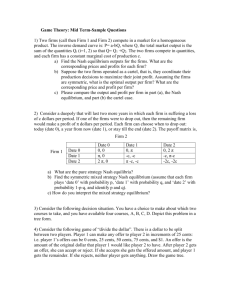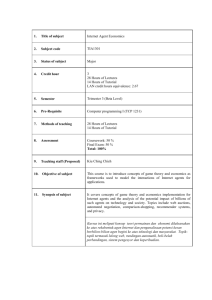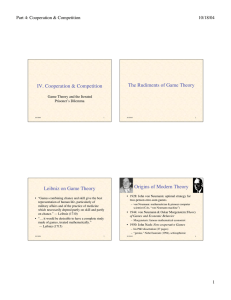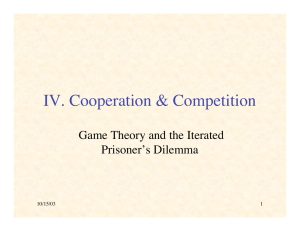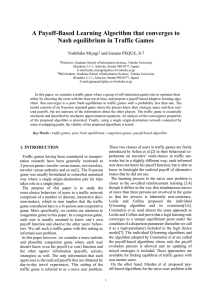Game Theory
advertisement
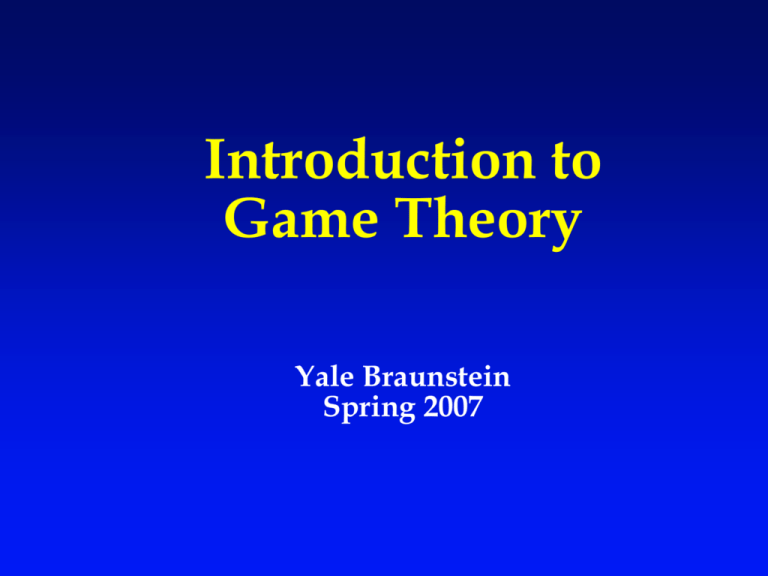
Introduction to Game Theory Yale Braunstein Spring 2007 General approach Brief History of Game Theory Payoff Matrix Types of Games Basic Strategies Evolutionary Concepts Limitations and Problems Brief History of Game Theory 1913 - E. Zermelo provides the first theorem of game theory; asserts that chess is strictly determined 1928 - John von Neumann proves the minimax theorem 1944 - John von Neumann & Oskar Morgenstern write "Theory of Games and Economic Behavior” 1950-1953 - John Nash describes Nash equilibrium Rationality Assumptions: humans are rational beings humans always seek the best alternative in a set of possible choices Why assume rationality? narrow down the range of possibilities predictability Utility Theory Utility Theory based on: rationality maximization of utility may not be a linear function of income or wealth It is a quantification of a person's preferences with respect to certain objects. What is Game Theory? Game theory is a study of how to mathematically determine the best strategy for given conditions in order to optimize the outcome Game Theory Finding acceptable, if not optimal, strategies in conflict situations. Abstraction of real complex situation Game theory is highly mathematical Game theory assumes all human interactions can be understood and navigated by presumptions. Why is game theory important? All intelligent beings make decisions all the time. AI needs to perform these tasks as a result. Helps us to analyze situations more rationally and formulate an acceptable alternative with respect to circumstance. Useful in modeling strategic decision-making Games against opponents Games against "nature„ Provides structured insight into the value of information Types of Games Sequential vs. Simultaneous moves Single Play vs. Iterated Zero vs. non-zero sum Perfect vs. Imperfect information Cooperative vs. conflict Zero-Sum Games The sum of the payoffs remains constant during the course of the game. Two sides in conflict Being well informed always helps a player Non-zero Sum Game The sum of payoffs is not constant during the course of game play. Players may co-operate or compete Being well informed may harm a player. Games of Perfect Information The information concerning an opponent’s move is well known in advance. All sequential move games are of this type. Imperfect Information Partial or no information concerning the opponent is given in advance to the player’s decision. Imperfect information may be diminished over time if the same game with the same opponent is to be repeated. Key Area of Interest chance strategy Matrix Notation (Column) Player II (Row) Player I Strategy A Strategy B Strategy A (P1, P2) (P1, P2) Strategy B (P1, P2) (P1, P2) Notes: Player I's strategy A may be different from Player II's. P2 can be omitted if zero-sum game Prisoner’s Dilemma & Other famous games A sample of other games: Marriage Disarmament (my generals are more irrational than yours) Prisoner’s Dilemma NCE Notes: Higher payoffs (longer sentences) are bad. Jt. max. Non-cooperative equilibrium Joint maximum Institutionalized “solutions” (a la criminal organizations, KSM) Games of Conflict Two sides competing against each other Usually caused by complete lack of information about the opponent or the game Characteristic of zero-sum games Games of Co-operation Players may improve payoff through communicating forming binding coalitions & agreements do not apply to zero-sum games Prisoner’s Dilemma with Cooperation Prisoner’s Dilemma with Iteration Infinite number of iterations Fear of retaliation Fixed number of iteration Domino effect Basic Strategies 1. Plan ahead and look back 2. Use a dominating strategy if possible 3. Eliminate any dominated strategies 4. Look for any equilibrium 5. Mix up the strategies Plan ahead and look back If you have a dominating strategy, use it Use strategy 1 Eliminate any dominated strategy Eliminate strategy 2 as it’s dominated by strategy 1 Look for any equilibrium Dominating Equilibrium Minimax Equilibrium Nash Equilibrium Maximin & Minimax Equilibrium Minimax - to minimize the maximum loss (defensive) Maximin - to maximize the minimum gain (offensive) Minimax = Maximin Maximin & Minimax Equilibrium Strategies Definition: Nash Equilibrium “If there is a set of strategies with the property that no player can benefit by changing her strategy while the other players keep their strategies unchanged, then that set of strategies and the corresponding payoffs constitute the Nash Equilibrium. “ Source: http://www.lebow.drexel.edu/economics/mccain/game/game.html Is this a Nash Equilibrium? Boxed Pigs Example Cost to press button = 2 units When button is pressed, food given = 10 units Decisions, decisions... Time for "real-life" decision making Holmes & Moriarity in "The Final Problem" What would you do… If you were Holmes? If you were Moriarity? Possibly interesting digressions? Why was Moriarity so evil? What really happened? –What do we mean by reality? –What changed the reality? Mixed Strategy Mixed Strategy Solution Value in Safe Safe 1 Safe 2 Both $ $ $ 10,000 100,000 110,000 Probability of being Guarded 1 / 11 10 / 11 Expected Loss $ 9,091 $ 9,091 The Payoff Matrix for Holmes & Moriarity Player #2 Strategy #1 P l a y e r # 1 Strategy #2 Strategy #1 Payoff (1,1) Strategy #2 Payoff (2,1) Payoff (1,2) Payoff (2,2) Where is game theory currently used? – Ecology – Networks – Economics Limitations & Problems Assumes players always maximize their outcomes Some outcomes are difficult to provide a utility for Not all of the payoffs can be quantified Not applicable to all problems Summary What is game theory? Abstraction modeling multi-person interactions How is game theory applied? Payoff matrix contains each person’s utilities for various strategies Who uses game theory? Economists, Ecologists, Network people,... How is this related to AI? Provides a method to simulate a thinking agent Sources Much more available on the web. These slides (with changes and additions) adapted from: http://pages.cpsc.ucalgary.ca/~jacob/Courses/Winter2000/CPSC533/Pages/i ndex.html Three interesting classics: John von Neumann & Oskar Morgenstern, Theory of Games & Economic Behavior (Princeton, 1944). John McDonald, Strategy in Poker, Business & War (Norton, 1950) Oskar Morgenstern, "The Theory of Games," Scientific American, May 1949; translated as "Theorie des Spiels," Die Amerikanische Rundschau, August 1949.




